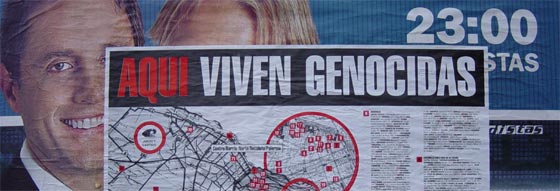
|
Disobedience Disobedience will be presented in two venues: Play_gallery for still
and motion pictures |
Alterazioni Video, Argentina Arde, Delphine Bedel, Franco Berardi (Bifo), Beth Bird, Black Audio Film Collective, Jota Castro, La Comunitaria TV, Critical Art Ensemble (CAE), Marcelo Expósito, Harun Farocki, Ronith Gitelman & José Ignacio Lezcano, Alberto Grifi, Grupo de Arte Callejero (GAC), Guerrillavision, Indymedia, kanalB, Makrolab, Gianni Motti, Paper Tiger TV, Margit Czenki/Park Fiction, Radek Community, Oliver Ressler, Paola Salerno, Hito Steyerl, Socialist Resistance, Sven’t Jolle, The Yes Men, Tute Bianche, Andrei Ujica, Ultra-red, Ambrogio Vitali/Radio Alice, Videoteppisti, Paolo Virno, Peter Watkins, Wayruro…
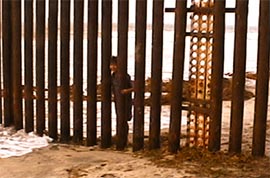 |
|
Disobedience is an exhibition and a video station on the relationship between artistic practice and civil disobedience. It developed from a co-operation between Playgallery for still and motion pictures, transmediale 05 and the Kunstraum Kreuzberg/Bethanien. Conceived as a diverse and constantly changing archive, the project represents a guide to the geography of civil disobedience, from the social struggles in Italy in 1977 to the recent anti-globalisation protests before and after Seattle. The project is also an atlas of the plurality of resistance tactics such as direct action, counter-information and biological disobedience. By setting in motion different signs and situations, Disobedience is presented as a network of open topics, brought together by artists, activists, film producers, philosophers and political groups. Each of them was invited to create a separate section by involving other artists and documents.
Interventionists, activists and media collectives have penetrated the medium of exhibitions, while artists cast aside visual stimuli for action and take to the streets to produce public forums, activist campaigns as well a symbols and mechanisms of protest. Some talk of a return to the political art of the seventies, others of an "ambiguous" return. Martha Rosler recommends re-reading Adorno as a deterrent against a drift towards a mainstream phenomenon. Steve Kurtz of the collective Critical Art Ensemble (CAE) was arrested by the FBI as a suspected bio-terrorist. Some questions remain: Is the post-Seattle movement thus only a remake (albeit an on-line version) of the past? Are the problems the same, after the disappearance of the socialist framework and the diversity of production in post-Fordist times? If this is no longer possible, can we retain a clear separation between intellectual production, political action and culture? Or is it nearly inconceivable to differentiate work from other human activities?
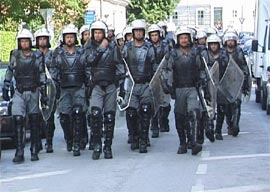 |
|
The goal of Disobedience is to create a common space for artistic production and for political action. It means understanding that society itself is changing, and with it, the language it produces as a political subject and as a media object. The construction of images defines the strata of social relationships in our societies and, as Debord postulated, perceptibly unites what already exists in separate form. The direct intervention of a grassroots political activism - the call for change as well as the possibility to achieve consent – is always measured by its ability to shatter existing political structures, to point out new ways for practicing the public realm, to create non-traditional forms of political intervention and to configure new antagonisms and forms of disagreement.
Still, the decision to focus attention on civil disobedience is based on another reason. Some defined civil disobedience as the "basic form of political action of the moltitude". Outside the liberal tradition, where civil disobedience of the masses has been used since the time of Thoreau, but also far removed from the desire for it to be constitutionalized - as Hannah Arendt wanted it -, moltitude civil disobedience cannot negotiate with the state. It questions its authority. While civil disobedience does not mean merely breaking the law, defection demands an approval of our potential to produce images and communicate by generalizing what has traditionally been artistic practice.
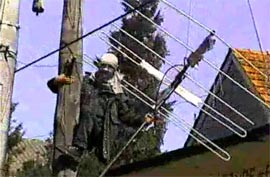 |
|
Disobedience presents itself as a comprehensive map of the conflict and as a network of contemporary activism. The exhibition takes the visitor through ten rooms in the two spaces of Play Gallery and Kunstraum Kreuzberg/Bethanien. Each room is an independent part of a central, historic platform and contains a collection of original material from the 1977 uprising in Italy. An information area contains books, flyers, magazines and posters from and about the 1970s political scene. A time-line chronologically orders the main events from 1976 to 1978, including Alberto Grifi’s filming of the Parco Lambro demonstration in Milan, the trade union leader Luciano Lama’s expulsion from the University of Rome, the violent riots in Bologna - documented by Italian Videoteppisti - and audio tracks from Radio Alice. The section on the 1977 movement homes in on the uniqueness and isolation of the Italian situation, as a direct precursor of post-Fordism.
Other sections of the show explore the relationship between art and activism of the post-communist era in Eastern Europe (the film by Farocki and Ujica on the process of the demonstrators against Ceausescu and the protest against the FMI in Prague), the world-wide movement against neo-liberalism (from the crisis in Argentina to the G8-summit in the Ressler section), demands for reformed social housing policy (the Park Fiction group in Hamburg to the work of Ultra-Red in Los Angeles), the struggle for civil rights, demonstrations by mine workers such as in Vallone (Jota Castro), culture-jamming practices and AIDS awareness activism. The show emphasizes these forms of disobedience, in which the 'exodus' and the 'exit' (according to the definitions of Albert O. Hirschman) represent the most important expression of civil disobedience in this era of post-Fordism. Forms of self-organization, alternative production processes, constituent practices.
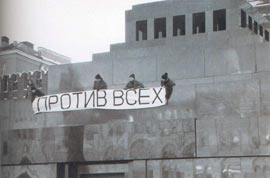 |
|
Also set up at the Play Gallery will be workstations and temporary workshops in which scientific and artistic elements experiment on “sabotage” computer programming and biogenetic engineering. A special section is dedicated to Makrolab, the station founded by Slovene artist Marko Peljhan in 1997 to intercept satellite channels and data from around the world. Another section is Molecular Invasion by the Critical Art Ensemble (CAE). This is a project of public experiments on vegetable organisms, with a view to proposing a contestational biology and tamper with biotechnologies.
Disobedience was designed as a long-term work-in-progress and as such can only be presented as a non-comprehensive and provisional archive, intended to increase and expand gradually over time.
Spectators are encouraged to make suggestions and add other cases to the video archive in progress.
Read more:
- DISOBEDIENCE AND COGNITARIAT / A conversation with Franco Berardi (Bifo)
-
EXODUS, UNIQUENESS AND MULTITUDE /
Interview of Marco Scotini with Paolo Virno